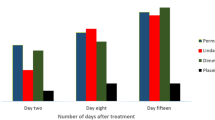Abstract
Because topical compounds based on insecticidal chemicals are the mainstay of head lice treatment, but resistance is increasing, alternatives, such as herbs and oils are being sold to treat head lice. To test a commercial shampoo based on seed extract of Azadirachta indica (neem tree) for its in vitro effect, head lice (n=17) were collected from school children in Australia and immersed in Wash-Away Louse™ shampoo (Alpha-Biocare GmbH, Germany). Vitality was evaluated for more than 3 h by examination under a dissecting microscope. Positive and negative controls were a commercially available head lice treatment containing permethrin 1% (n=19) and no treatment (n=14). All lice treated with the neem shampoo did not show any vital signs from the initial examination after immersion at 5–30 min; after 3 h, only a single louse showed minor signs of life, indicated by gut movements, a mortality of 94%. In the permethrin group, mortality was 20% at 5 min, 50% at 15 min, and 74% after 3 h. All 14 head lice of the negative control group survived during the observation period. Our data show that Wash-Away Louse™ is highly effective in vitro against head lice. The neem shampoo was more effective than the permethrin-based product. We speculate that complex plant-based compounds will replace the well-defined chemical pediculicides if resistance to the commonly used products further increases.


Similar content being viewed by others
References
Burgess IF (2004) Human lice and their control. Annu Rev Entomol 49:457–481
Burkhart CG, Burkhart CN (2006) Safety and efficacy of pediculicides for head lice. Expert Opin Drug Saf 5:169–179
Burkhart CG, Burkhart CN, Burkhart KM (1998) An assessment of topical and oral prescription and over-the-counter treatments for head lice. J Am Acad Dermatol 38:979–982
Dasgupta T, Banerjee S, Yadava PK, Rao AR (2004) Chemopreventive potential of Azadirachta indica (Neem) leaf extract in murine carcinogenesis model systems. J Ethnopharmacol 92:23–36
Downs AM, Stafford KA, Hunt LP, Ravenscroft JC, Coles GC (2002) Widespread insecticide resistance in head lice to the over-the-counter pediculocides in England, and the emergence of carbaryl resistance. Br J Dermatol 146:88–93
Elston DM (2003) Drug-resistant lice. Arch Dermatol 139:1061–1064
Ghaffar FA, Semmler M (2006) Effects of new neem extracts on head lice in heavily infested persons. Parasitol Res in press
Heukelbach J, Feldmeier H (2004) Ectoparasites—the underestimated realm. Lancet 363:889–891
Hunter JA, Barker SC (2003) Susceptibility of head lice (Pediculus humanus capitis) to pediculicides in Australia. Parasitol Res 90:476–478
Knust FJ (1998) Neem-Therapie der Pediculosis capitis und der Scabies im Kindesalter. Arzt Umw 11:319–322
Li SY, Skinner AC, Rideout T et al (2003) Lethal and sublethal effects of a neem-based insecticide on balsam fir sawfly (Hymenoptera: Diprionidae). J Econ Entomol 96:35–42
McCage CM, Ward SM, Paling CA et al (2002) Development of a paw paw herbal shampoo for the removal of head lice. Phytomedicine 9:743–748
Mougabure CG, Gonzalez AP, Vassena CV, Picollo MI, Zerba EN (2002) Toxic effect of aliphatic alcohols against susceptible and permethrin-resistant Pediculus humanus capitis (Anoplura: Pediculidae). J Med Entomol 39:457–460
Mulla MS, Su T (1999) Activity and biological effects of neem products against arthropods of medical and veterinary importance. J Am Mosq Control Assoc 15:133–152
Mumcuoglu KY, Hemingway J, Miller J et al (1995) Permethrin resistance in the head louse Pediculus capitis from Israel. Med Vet Entomol 9:427–432, 447
Mumcuoglu KY, Magdassi S, Miller J et al (2004) Repellency of citronella for head lice: double-blind randomized trial of efficacy and safety. Isr Med Assoc J 6:756–759
Mumcuoglu KY, Miller J, Zamir C et al (2002) The in vivo pediculicidal efficacy of a natural remedy. Isr Med Assoc J 4:790–793
Oladimeji FA, Orafidiya OO, Ogunniyi TA, Adewunmi TA (2000) Pediculocidal and scabicidal properties of Lippia multiflora essential oil. J Ethnopharmacol 72:305–311
Picollo MI, Vassena CV, Mougabure Cueto GA, Vernetti M, Zerba EN (2000) Resistance to insecticides and effect of synergists on permethrin toxicity in Pediculus capitis (Anoplura: Pediculidae) from Buenos Aires. J Med Entomol 37:721–725
Tiangda CH, Gritsanapan W, Sookvanichsilp N, Limchalearn A (2000) Anti-headlice activity of a preparation of Annona squamosa seed extract. Southeast Asian J Trop Med Public Health 31(Suppl 1):174–177
Tross R, Bernauer-Jacob V, Hummel E, Kleeberg H (1998) AzadirachtinA-content and bio-efficacy in hair treated with NeemAzal Fomulations. In: H Kleeberg (ed) Practice oriented results on use and production of neem-ingredients and pheromones VII. Druck und Graphic, p 9–20
Yang YC, Choi HY, Choi WS, Clark JM, Ahn YJ (2004a) Ovicidal and adulticidal activity of Eucalyptus globulus leaf oil terpenoids against Pediculus humanus capitis (Anoplura: Pediculidae). J Agric Food Chem 52:2507–2511
Yang YC, Lee HS, Clark JM, Ahn YJ (2004b) Insecticidal activity of plant essential oils against Pediculus humanus capitis (Anoplura: Pediculidae). J Med Entomol 41:699–704
Yang YC, Lee HS, Lee SH, Clark JM, Ahn YJ (2005) Ovicidal and adulticidal activities of Cinnamomum zeylanicum bark essential oil compounds and related compounds against Pediculus humanus capitis (Anoplura: Pediculicidae). Int J Parasitol 35:1595–1600
Yoon KS, Gao JR, Lee SH et al (2003) Permethrin-resistant human head lice, Pediculus capitis, and their treatment. Arch Dermatol 139:994–1000
Acknowledgements
The authors thank Chris Cahill for assistance in obtaining head lice. Wash-Away Louse™ neem shampoo was provided free of charge by Alpha Biocare GmbH, Düsseldorf, Germany. Jorg Heukelbach was supported by an Endeavour Australia Research Fellowship.
Author information
Authors and Affiliations
Corresponding author
Rights and permissions
About this article
Cite this article
Heukelbach, J., Oliveira, F.A.S. & Speare, R. A new shampoo based on neem (Azadirachta indica) is highly effective against head lice in vitro. Parasitol Res 99, 353–356 (2006). https://doi.org/10.1007/s00436-006-0146-7
Received:
Accepted:
Published:
Issue Date:
DOI: https://doi.org/10.1007/s00436-006-0146-7




